
As one very wise cinephile once put it, “Every Disney film is someone’s favorite movie.”
Editor / author Daniel Kothenschulte tried to keep that in mind over the past two years as he worked on “The Walt Disney Film Archives: The Animated Movies 1921 – 1968” ( TASCHEN America, October 2016). But given that he only had so many pages to work with as Kothenschulte tried to cover this massive chunk of Mouse House history, Daniel began the pruning process almost as soon as he entered Disney’s Animation Research Library (i.e., that climate-controlled, high security structure where Walt Disney Animation Studios has an estimated 65 million pieces of art in storage).
“This addition to TASCHEN’s ‘Archives’ series of film books was originally supposed to have been 800 – 900 pages,” Kothenschulte recalled during a recent phone interview. ‘But given that we wanted this volume to be filled with lots of large illustrations that had been scanned at high resolution … Well, at some point, you have to start taking into consideration the size of the pages you’ll be working with as well as the weight of the paper you’ll be printing your book on. And since we wanted film fans to actually be able to lift this Disney film book, that then began limiting what we could put into this volume.”
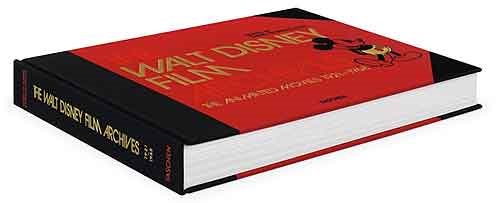 Copyright TASCHEN. All rights reserved
Copyright TASCHEN. All rights reserved
Mind you, given that “The Walt Disney Film Archives” is 620 pages long (More importantly, given that this 18.8 by 2.5 by 12.8 inch volume weighs a whopping 13.8 pounds), there isn’t a movie buff on the planet who would dare to call this book skimpy. But even though it features 1500 pieces of artwork that were carefully culled from the ARL’s collection (Not to mention entertaining & informative essays written by some of the top animation historians working today. Among them Didier Ghez , J.B. Kaufman & Disney Legend Dave Smith ), Daniel still reflects on the book that might have been.
“Of course, we had to represent all of the animated features that Walt had worked on. Plus a good selection of Disney’s shorts. But it kind of broke my heart that we weren’t able to do more with those featurettes that Walt Disney Animation Studios made back in the 1940s, 1950s & 1960s. Those films were made by the exact same great artists who worked on Disney’s full-length animated features. They actually feel like little features. They’re special and unique. I just wish that we’d been able to do more with those,” Kothenschulte lamented.
What’s kind of ironic here is that Daniel first learned about the ARL’s artistic treasure when he was paging through another great film history book, Charles Solomon’s “The Disney That Never Was: The Stories and Art from Five Decades of Unproduced Animation” (Hyperion Press, November 1995).
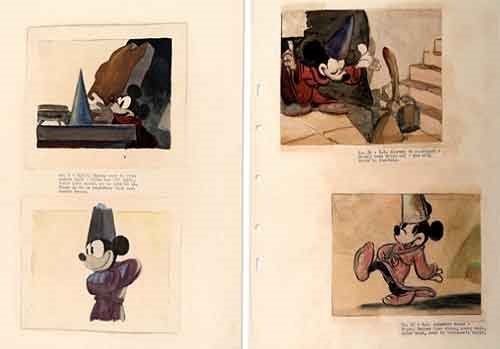 Copyright Disney / TASCHEN. All rights reserved
Copyright Disney / TASCHEN. All rights reserved
‘I remember reading that book in my early 20s. And the artwork that Charles had in there from sequences that were developed for Disney’s concert feature but never completed just fascinated me. Mind you, they were only a few images from those abandoned ‘Fantasia’ sequences in that Solomon book. But that artwork so fascinated me that I think that they were the very first pieces that I asked Fox to pull once I was actually invited to visit the ARL,” Kothenschulte stated.
That’s Fox Carney – the Manager of Research at the Walt Disney Animation Research Library – which Daniel is talking about. And Carney and his crew at the ARL were more than happy to pull some of the rarer-than-rare images out of their flat files as Kothenschulte was just beginning the research portion of this then-proposed addition to TASCHEN’s “Archives” series.
“It was a pleasure to have Daniel here,” Carney said. “And for those of us who work at the ARL, we always get a kick of bringing art to a table for someone to look at that maybe they haven’t seen before and then just watch their jaws drop open.”
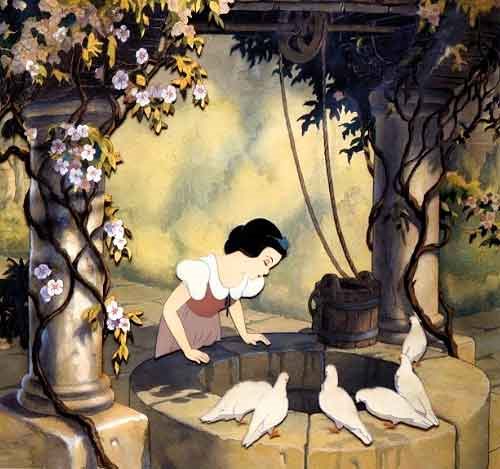 Copyright Disney / TASCHEN. All rights reserved
Copyright Disney / TASCHEN. All rights reserved
“That happened a lot of times while I was working on this book,” Daniel laughed.
So what sort of treasures can one expect to see when they finally pick up this hefty film history book? To hear Carney & Kothenschulte talk, striking just the right balance with “The Walt Disney Film Archives: The Animated Movies 1921 – 1968” was tricky.
“When we first began digging through our collection, our goal was to provide Daniel with some really novel pieces that hadn’t ever been seen before. But – at the same time – because we knew that the team at TASCHEN was going to do a wonderful job when it came to the reproduction of images for this book … Well, there are were some pieces in here, some pastels that might be familiar to animation fans. But these images honestly have never looked better than they do in this new book,” Fox enthused.
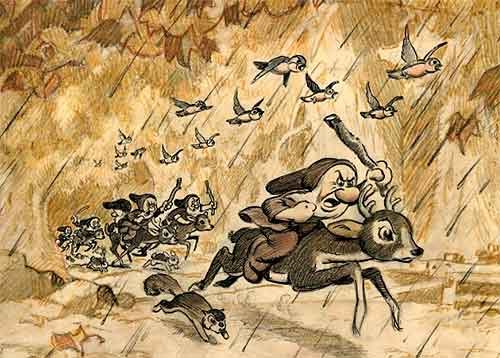 Copyright Disney / TASCHEN. All rights reserved
Copyright Disney / TASCHEN. All rights reserved
In addition to the amazing imagery, there are some never-before-told tales in “The Walt Disney Film Archives” that are just going to amaze animation fans. Take – for example – this story that Berlin-based film journalist Katja Lüthge shares about the development of 1947’s “Fun and Fancy Free.” Believe it or not, the “Mickey and the Beanstalk” portion of this package feature came about because …
… in an early story conference, Walt Disney wanted to motivate Mickey’s appearance in a feature film with, of all things, a studio strike. On May 2, 1940, he spontaneously shared his idea: “We could use the opening business where Mickey, Don and the Goof are protesting – they’re going on strike – they want to work in features. Have (these) … characters (carry signs which read) “Disney Unfair to Short-Subject Actors” …
Now when you consider that – almost exactly one year later (on May 29, 1941 to be exact) – 334 Disney Studio employees went out on strike and almost immediately began picketing their place of work. Carrying virtually identical signs (i.e., “Disney Unfair to His Artists”) to the ones that Walt once proposed that Mickey, Donald & Goofy carry in their feature film debut … Well, you honestly can’t get much more ironic than that.
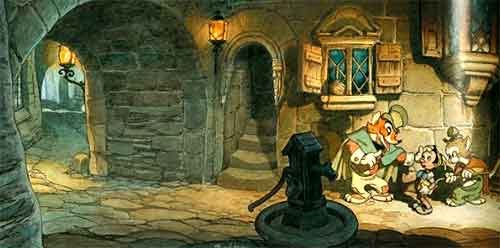 Copyright Disney / TASCHEN. All rights reserved
Copyright Disney / TASCHEN. All rights reserved
But that’s what’s really great about “The Walt Disney Film Archives: The Animated Movies 1921 – 1968.” Daniel’s determination to build on what Charles Solomon did with “The Disney That Never Was.” Dig down deep into the ARL’s expansive collection (which – in an interesting side note here – the Company has recently begun digitizing. Just this past summer, Carney and the ARL image capture team reached a huge milestone: Their millionth image scanned) to share images & stories about proposed animated features that ultimately never made it off of Disney’s drawing board.
Take – for example – “Hiawatha.” In an essay that Kothenschulte himself wrote, it is revealed that …
Walt Disney’s admiration for (Henry Wadsworth) Longfellow’s portrait of the life of a Native American in the 16th century … inspired him to continue looking for ideas for a possible adaptation. In 1943, development of a serious dramatic adaptation began, which brought about Kelsey’s epic storyboard in 1948 and 1949.
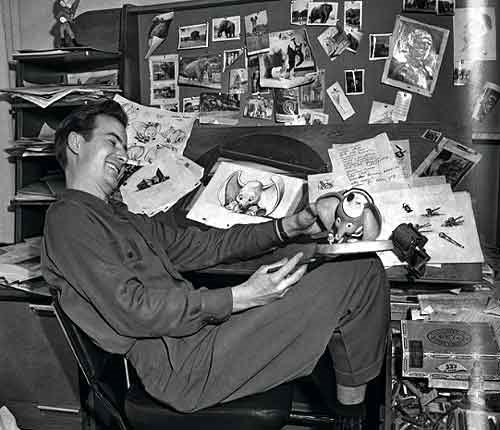 Copyright Disney / TASCHEN. All rights reserved
Copyright Disney / TASCHEN. All rights reserved
That’s Dick Kelsey – one of the untrue unsung stars of Walt Disney Animation Studios’ first golden age – that Daniel is talking about. Walt was so sure that there was enormous potential for an truly ambitious animated feature material in “Hiawatha” (more importantly, that he thought so highly of Dick’s artistic abilities) that – starting in September of 1948 – Disney sent Kelsey on a six week-long trip to the Great Lakes Region. Where Dick was to then document & sketch many of the settings from Longfellow’s famous narrative poem.
As an Associated press story that was published before Dick began his journey, what this Disney artist was attempting …
… will be no easy task in this modern era since (Kelsey) insists he will try to recapture both the spirit and the look of Hiawatha’s land. Every remaining forest, prairie, lake and river associated with the Indian legend will be visited by boat, automobile, train, horse or on foot, (Dick) declared. He has arranged to study museum material in Chicago, St Paul, Minneapolis, and Rochester the American Museum of Natural History and the Heye Foundation in New York and the Smithsonian Institute and the Bureau of Indian Affairs in Washington. At Naples, NY (Kelsey) will confer with Dr. Arthur C. Parker, director emeritus of the Rochester Museum, an authority on American Indian life and lore.
 Copyright Disney / TASCHEN. All rights reserved
Copyright Disney / TASCHEN. All rights reserved
All of this research did ultimately pay off. For those “Hiawatha” storyboards that Dick produced – all in pastels, mind you – once he returned to Disney Studios were stunning.
“And the thing – with drawings that are done with pastels – is that they can be really tricky to reproduce. But because Daniel and the team at TASCHEN spared no expense when they were putting together ‘The Walt Disney Film Archives: The Animated Movies 1921 – 1968,’ the images from ‘Hiawatha’ that are included in this book are simply stunning,” Fox stated. “The fires and the fireplaces that Dick drew, the glowing arrows and such, they just really stand out. The colors of the foliage are just amazing. “
And for every seldom-seen / recently unearthed image that you’ll find in this 620-page tome, you also find a story that perhaps a previous management team at the Mouse House would have preferred that Kothenschulte had kept buried. Take – for example – this somewhat startling behind-the-scenes tale that Brian Sibley shares in his essay about the Studios’ 1963 release, “The Sword and the Stone.” It would seem that Walt’s brother …
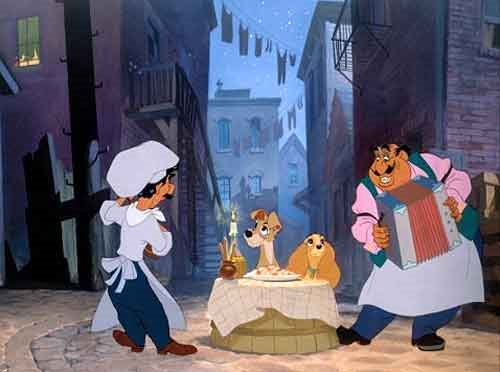 Copyright Disney / TASCHEN. All rights reserved
Copyright Disney / TASCHEN. All rights reserved
… Roy O. Disney, who was of the opinion that since the Studio had a significant catalog of films available for re-release on a regular basis, (felt that – as of the early 1960s – production of) new animated features were far from essential.
But since Daniel was determined to make the newest title in TASCHEN’s ‘Archives’ series of film books as truthful & as far-reaching as he possibly could, this ambitious writer / editor kept that somewhat embarrassing story in “The Walt Disney Film Archives: The Animated Movies 1921 – 1968.”
“It was a question of history, of film history,” Kothenschulte concluded. “Besides, my girl friend’s favorite Disney film is ‘The Sword and the Stone.’ And ‘Robin Hood.’ “
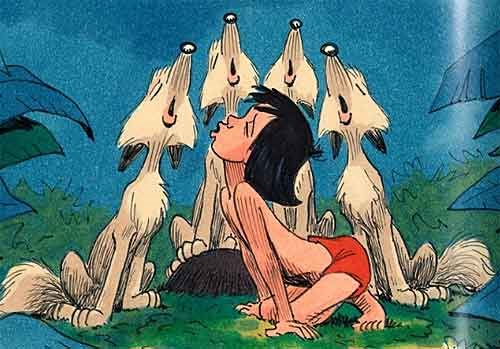 Copyright Disney / TASCHEN. All rights reserved
Copyright Disney / TASCHEN. All rights reserved
FYI: You won’t find anything about Disney’s 1973 animated take on the tales of Robin Hood and his Merry Men. That information is being currently saved for TASCHEN’s proposed follow-up to “The Walt Disney Film Archives.” But before that comes the book that Daniel has already begun working on, which will be yet another hefty Disney-related volume.
“My next project is supposed to be a book on Walt Disney’s life and art. Since this project is supposed to be more focused on Walt the man, it will have many, many photographs of his personal life. And – once again – lots of wonderful artwork from Disney’s animated features,” Daniel said. “So that should be the next one. Mind you, it will be different than ‘The Walt Disney Film Archives.” More like an art book. More like – I don’t know – maybe like a book about the life & art of Leonardo. You know, that’s what some people called Walt back in the 1930s: Leonardo da Disney. So maybe this will be TASCHEN’s Leonardo da Disney book.
Well, all I know – if the 13.8 pound “The Walt Disney Film Archives: The Animated Movies 1921 – 1968” is any indication of what Kothenschulte & TASCHEN will be doing with their proposed “Leonardo da Disney” book – now might be a really good time for animation fans to go out and buy a good, steel-reinforced bookcase.
This article was originally published by the Huffington Post on Wednesday, November 2, 2016

History
The Evolution and History of Mickey’s ToonTown

Disneyland in Anaheim, California, holds a special place in the hearts of Disney fans worldwide, I mean heck, it’s where the magic began after all. Over the years it’s become a place that people visit in search of memorable experiences. One fan favorite area of the park is Mickey’s Toontown, a unique land that lets guests step right into the colorful, “Toony” world of Disney animation. With the recent reimagining of the land and the introduction of Micky and Minnies Runaway Railway, have you ever wondered how this land came to be?
There is a fascinating backstory of how Mickey’s Toontown came into existence. It’s a tale of strategic vision, the influence of Disney executives, and a commitment to meeting the needs of Disney’s valued guests.
The Beginning: Mickey’s Birthdayland
The story of Mickey’s Toontown starts with Mickey’s Birthdayland at Walt Disney World’s Magic Kingdom. Opened in 1988 to celebrate Mickey Mouse’s 60th birthday, this temporary attraction was met with such overwhelming popularity that it inspired Disney executives to think bigger. The idea was to create a permanent, immersive land where guests could step into the animated world of Mickey Mouse and his friends.
In the early ’90s, Disneyland was in need of a refresh. Michael Eisner, the visionary leader of The Walt Disney Company at the time, had an audacious idea: create a brand-new land in Disneyland that would celebrate Disney characters in a whole new way. This was the birth of Mickey’s Toontown.
Initially, Disney’s creative minds toyed with various concepts, including the idea of crafting a 100-Acre Woods or a land inspired by the Muppets. However, the turning point came when they considered the success of “Who Framed Roger Rabbit.” This film’s popularity and the desire to capitalize on contemporary trends set the stage for Toontown’s creation.
From Concept to Reality: The Birth of Toontown
In 1993, Mickey’s Toontown opened its gates at Disneyland, marking the first time in Disney Park history where guests could experience a fully realized, three-dimensional world of animation. This new land was not just a collection of attractions but a living, breathing community where Disney characters “lived,” worked, and played.
Building Challenges: Innovative Solutions
The design of Mickey’s Toontown broke new ground in theme park aesthetics. Imagineers were tasked with bringing the two-dimensional world of cartoons into a three-dimensional space. This led to the creation of over 2000 custom-built props and structures that embodied the ‘squash and stretch’ principle of animation, giving Toontown its distinctiveness.
And then there was also the challenge of hiding the Team Disney Anaheim building, which bore a striking resemblance to a giant hotdog. The Imagineers had to think creatively, using balloon tests and imaginative landscaping to seamlessly integrate Toontown into the larger park.

Key Attractions: Bringing Animation to Life
Mickey’s Toontown featured several groundbreaking attractions. “Roger Rabbit’s Car Toon Spin,” inspired by the movie “Who Framed Roger Rabbit,” became a staple of Toontown, offering an innovative ride experience. Gadget’s Go-Coaster, though initially conceived as a Rescue Rangers-themed ride, became a hit with younger visitors, proving that innovative design could create memorable experiences for all ages.
Another crown jewel of Toontown is Mickey’s House, a walkthrough attraction that allowed guests to explore the home of Mickey Mouse himself. This attraction was more than just a house; it was a carefully crafted piece of Disney lore. The house was designed in the American Craftsman style, reflecting the era when Mickey would have theoretically purchased his first home in Hollywood. The attention to detail was meticulous, with over 2000 hand-crafted, custom-built props, ensuring that every corner of the house was brimming with character and charm. Interestingly, the design of Mickey’s House was inspired by a real home in Wichita Falls, making it a unique blend of real-world inspiration and Disney magic.
Mickey’s House also showcased Disney’s commitment to creating interactive and engaging experiences. Guests could make themselves at home, sitting in Mickey’s chair, listening to the radio, and exploring the many mementos and references to Mickey’s animated adventures throughout the years. This approach to attraction design – where storytelling and interactivity merged seamlessly – was a defining characteristic of ToonTown’s success.

Executive Decisions: Shaping ToonTown’s Unique Attractions
The development of Mickey’s Toontown wasn’t just about creative imagination; it was significantly influenced by strategic decisions from Disney executives. One notable input came from Jeffrey Katzenberg, who suggested incorporating a Rescue Rangers-themed ride. This idea was a reflection of the broader Disney strategy to integrate popular contemporary characters and themes into the park, ensuring that the attractions remained relevant and engaging for visitors.
In addition to Katzenberg’s influence, Frank Wells, the then-President of The Walt Disney Company, played a key role in the strategic launch of Toontown’s attractions. His decision to delay the opening of “Roger Rabbit’s Car Toon Spin” until a year after Toontown’s debut was a calculated move. It was designed to maintain public interest in the park by offering new experiences over time, thereby giving guests more reasons to return to Disneyland.
These executive decisions highlight the careful planning and foresight that went into making Toontown a dynamic and continuously appealing part of Disneyland. By integrating current trends and strategically planning the rollout of attractions, Disney executives ensured that Toontown would not only capture the hearts of visitors upon its opening but would continue to draw them back for new experiences in the years to follow.
Global Influence: Toontown’s Worldwide Appeal
The concept of Mickey’s Toontown resonated so strongly that it was replicated at Tokyo Disneyland and influenced elements in Disneyland Paris and Hong Kong Disneyland. Each park’s version of Toontown maintained the core essence of the original while adapting to its cultural and logistical environment.
Evolution and Reimagining: Toontown Today
As we approach the present day, Mickey’s Toontown has recently undergone a significant reimagining to welcome “Mickey & Minnie’s Runaway Railway” in 2023. This refurbishment aimed to enhance the land’s interactivity and appeal to a new generation of Disney fans, all while retaining the charm that has made ToonTown a beloved destination for nearly three decades.

Dive Deeper into ToonTown’s Story
Want to know more about Mickey’s Toontown and hear some fascinating behind-the-scenes stories, then check out the latest episode of Disney Unpacked on Patreon @JimHillMedia. In this episode, the main Imagineer who worked on the Toontown project shares lots of interesting stories and details that you can’t find anywhere else. It’s full of great information and fun facts, so be sure to give it a listen!
History
Unpacking the History of the Pixar Place Hotel

Pixar Place Hotel, the newly unveiled 15-story tower at the Disneyland Resort, has been making waves in the Disney community. With its unique Pixar-themed design, it promises to be a favorite among visitors.
However, before we delve into this exciting addition to the Disneyland Resort, let’s take a look at the fascinating history of this remarkable hotel.
The Emergence of the Disneyland Hotel
To truly appreciate the story of the Pixar Place Hotel, we must turn back the clock to the early days of Disneyland. While Walt Disney had the visionary ideas and funding to create the iconic theme park, he faced a challenge when it came to providing accommodations for the park’s visitors. This is where his friend Jack Wrather enters the picture.
Jack Wrather, a fellow pioneer in the television industry, stepped in to assist Walt Disney in realizing his dream. Thanks to the success of the “Lassie” TV show produced by Wrather’s company, he had the financial means to build a hotel right across from Disneyland.
The result was the Disneyland Hotel, which opened its doors in October 1955. Interestingly, the early incarnation of this hotel had more of a motel feel than a hotel, with two-story buildings reminiscent of the roadside motels popular during the 1950s. The initial Disneyland Hotel consisted of modest structures that catered to visitors looking for affordable lodging close to the park. While the rooms were basic, it marked the beginning of something extraordinary.
The Evolution: From Emerald of Anaheim to Paradise Pier
As Disneyland’s popularity continued to soar, so did the demand for expansion and improved accommodations. In 1962, the addition of an 11-story tower transformed the Disneyland Hotel, marking a significant transition from a motel to a full-fledged hotel.
The addition of the 11-story tower elevated the Disneyland Hotel into a more prominent presence on the Anaheim skyline. At the time, it was the tallest structure in all of Orange County. The hotel’s prime location across from Disneyland made it an ideal choice for visitors. With the introduction of the monorail linking the park and the hotel, accessibility became even more convenient. Unique features like the Japanese-themed reflecting pools added to the hotel’s charm, reflecting a cultural influence that extended beyond Disney’s borders.
Japanese Tourism and Its Impact
During the 1960s and 1970s, Disneyland was attracting visitors from all corners of the world, including Japan. A significant number of Japanese tourists flocked to Anaheim to experience Walt Disney’s creation. To cater to this growing market, it wasn’t just the Disneyland Hotel that aimed to capture the attention of Japanese tourists. The Japanese Village in Buena Park, inspired by a similar attraction in Nara, Japan, was another significant spot.
These attractions sought to provide a taste of Japanese culture and hospitality, showcasing elements like tea ceremonies and beautiful ponds with rare carp and black swans. However, the Japanese Village closed its doors in 1975, likely due to the highly competitive nature of the Southern California tourist market.
The Emergence of the Emerald of Anaheim
With the surge in Japanese tourism, an opportunity arose—the construction of the Emerald of Anaheim, later known as the Disneyland Pacific Hotel. In May 1984, this 15-story hotel opened its doors.
What made the Emerald unique was its ownership. It was built not by The Walt Disney Company or the Oriental Land Company (which operated Tokyo Disneyland) but by the Tokyu Group. This group of Japanese businessmen already had a pair of hotels in Hawaii and saw potential in Anaheim’s proximity to Disneyland. Thus, they decided to embark on this new venture, specifically designed to cater to Japanese tourists looking to experience Southern California.
Financial Challenges and a Changing Landscape
The late 1980s brought about two significant financial crises in Japan—the crash of the NIKKEI stock market and the collapse of the Japanese real estate market. These crises had far-reaching effects, causing Japanese tourists to postpone or cancel their trips to the United States. As a result, reservations at the Emerald of Anaheim dwindled.
To adapt to these challenging times, the Tokyu Group merged the Emerald brand with its Pacific hotel chain, attempting to weather the storm. However, the financial turmoil took its toll on the Emerald, and changes were imminent.
The Transition to the Disneyland Pacific Hotel
In 1995, The Walt Disney Company took a significant step by purchasing the hotel formerly known as the Emerald of Anaheim for $35 million. This acquisition marked a change in the hotel’s fortunes. With Disney now in control, the hotel underwent a name change, becoming the Disneyland Pacific Hotel.
Transformation to Paradise Pier
The next phase of transformation occurred when Disney decided to rebrand the hotel as Paradise Pier Hotel. This decision aligned with Disney’s broader vision for the Disneyland Resort.
While the structural changes were limited, the hotel underwent a significant cosmetic makeover. Its exterior was painted to complement the color scheme of Paradise Pier, and wave-shaped crenellations adorned the rooftop, creating an illusion of seaside charm. This transformation was Disney’s attempt to seamlessly integrate the hotel into the Paradise Pier theme of Disney’s California Adventure Park.
Looking Beyond Paradise Pier: The Shift to Pixar Place
In 2018, Disneyland Resort rebranded Paradise Pier as Pixar Pier, a thematic area dedicated to celebrating the beloved characters and stories from Pixar Animation Studios. As a part of this transition, it became evident that the hotel formally known as the Disneyland Pacific Hotel could no longer maintain its Paradise Pier theme.
With Pixar Pier in full swing and two successful Pixar-themed hotels (Toy Story Hotels in Shanghai Disneyland and Tokyo Disneyland), Disney decided to embark on a new venture—a hotel that would celebrate the vast world of Pixar. The result is Pixar Place Hotel, a 15-story tower that embraces the characters and stories from multiple Pixar movies and shorts. This fully Pixar-themed hotel is a first of its kind in the United States.
The Future of Pixar Place and Disneyland Resort
As we look ahead to the future, the Disneyland Resort continues to evolve. The recent news of a proposed $1.9 billion expansion as part of the Disneyland Forward project indicates that the area surrounding Pixar Place is expected to see further changes. Disneyland’s rich history and innovative spirit continue to shape its destiny.
In conclusion, the history of the Pixar Place Hotel is a testament to the ever-changing landscape of Disneyland Resort. From its humble beginnings as the Disneyland Hotel to its transformation into the fully Pixar-themed Pixar Place Hotel, this establishment has undergone several iterations. As Disneyland Resort continues to grow and adapt, we can only imagine what exciting developments lie ahead for this iconic destination.
If you want to hear more stories about the History of the Pixar Place hotel, check our special edition of Disney Unpacked over on YouTube.
Stay tuned for more updates and developments as we continue to explore the fascinating world of Disney, one story at a time.
History
From Birthday Wishes to Toontown Dreams: How Toontown Came to Be

In the latest release of Episode 4 of Disney Unpacked, Len and I return, joined as always by Disney Imagineering legend, Jim Shull . This two-part episode covers all things Mickey’s Birthday Land and how it ultimately led to the inspiration behind Disneyland’s fan-favorite land, “Toontown”. But let’s not get ahead of ourselves here. It all starts in the early days at Disneyland.
Early Challenges in Meeting Mickey
Picture this: it’s the late 1970s and early 1980s, and you’re at Disneyland. You want to meet the one and only Mickey Mouse, but there’s no clear way to make it happen. You rely on Character Guides, those daily printed sheets that point you in Mickey’s general direction. But let’s be honest, it was like finding a needle in a haystack. Sometimes, you got lucky; other times, not so much.

Mickey’s Birthdayland: A Birthday Wish that Came True
Fast forward to the late 1980s. Disney World faced a big challenge. The Disney-MGM Studios Theme Park was under construction, with the company’s marketing machine in full swing, hyping up the opening of Walt Disney World’s third theme park, MGM Studios, in the Spring of 1989. This extensive marketing meant that many people were opting to postpone their family’s next trip to Walt Disney World until the following year. Walt Disney World needed something compelling to motivate guests to visit Florida in 1988, the year before Disney MGM Studios opened.
Enter stage left, Mickey’s Birthdayland. For the first time ever, an entire land was dedicated to a single character – and not just any character, but the mouse who started it all. Meeting Mickey was no longer a game of chance; it was practically guaranteed.

The Birth of Birthdayland: Creative Brilliance Meets Practicality
In this episode, we dissect the birth of Mickey’s Birthdayland, an initiative that went beyond celebrating a birthday. It was a calculated move, driven by guest feedback and a need to address issues dating back to 1971. Imagineers faced the monumental task of designing an experience that honored Mickey while efficiently managing the crowds. This required the perfect blend of creative flair and logistical prowess – a hallmark of Disney’s approach to theme park design.
Evolution: From Birthdayland to Toontown
The success of Mickey’s Birthdayland was a real game-changer, setting the stage for the birth of Toontown – an entire land that elevated character-centric areas to monumental new heights. Toontown wasn’t merely a spot to meet characters; it was an immersive experience that brought Disney animation to life. In the episode, we explore its innovative designs, playful architecture, and how every nook and cranny tells a story.

Impact on Disney Parks and Guests
Mickey’s Birthdayland and Toontown didn’t just reshape the physical landscape of Disney parks; they transformed the very essence of the guest experience. These lands introduced groundbreaking ways for visitors to connect with their beloved characters, making their Disney vacations even more unforgettable.
Beyond Attractions: A Cultural Influence
But the influence of these lands goes beyond mere attractions. Our episode delves into how Mickey’s Birthdayland and Toontown left an indelible mark on Disney’s culture, reflecting the company’s relentless dedication to innovation and guest satisfaction. It’s a journey into how a single idea can grow into a cherished cornerstone of the Disney Park experience.

Unwrapping the Full Story of Mickey’s Birthdayland
Our two-part episode of Disney Unpacked is available for your viewing pleasure on our Patreon page. And for those seeking a quicker Disney fix, we’ve got a condensed version waiting for you on our YouTube channel . Thank you for being a part of our Disney Unpacked community. Stay tuned for more episodes as we continue to “Unpack” the fascinating world of Disney, one story at a time.

























